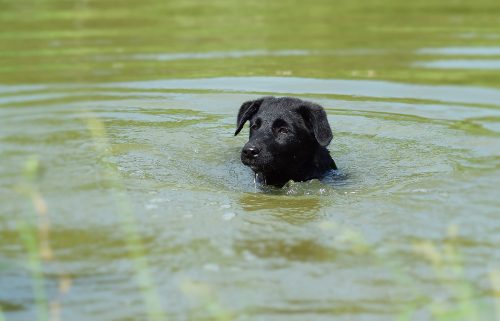Photo: Playforth, Laura. “Vets Now.” Vets Now, 25 Aug. 2019, www.vets-now.com/pet-care-advice/dogs-blue-green-algae-poisoning-treatment/.
Project Engineer, Lauren Takitch, Discusses Blue-Green Algae and its Environmental Impacts:
The past few weeks, I have been seeing more and more about blue-green algal blooms. I’d find numerous online posts of devastated dog owners having to say goodbye to their furry friends after spending a day playing fetch in a lake or river. I couldn’t help but wonder: What’s causing this? Why am I hearing about this so suddenly? And why are dogs the ones falling victim to these harmful algae blooms?
In researching these questions, I learned that blue-green alga is a toxic form of algae that contains cyanobacteria. When this bacteria decays, it releases cyanotoxins, as indicated by its turquoise color and unpleasant odor. These harmful toxins pose threats to animals, people, and the environment.
Dogs are most susceptible as they are most likely to swim in or ingest algae-containing waters. When dogs and other pets are exposed to these toxins, they may experience intense symptoms just hours to days after exposure. These symptoms include vomiting, diarrhea, disorientation, seizures, liver damage, and sometimes even death. Depending on the type and length of exposure, humans may also experience serious symptoms, such as skin, nose, eye, and throat irritation, abdominal pain, headache, vomiting, and diarrhea after encountering these toxins.
These blue-green algae blooms thrive in freshwater environments that are warm and rich in nutrients (i.e. nitrogen and phosphorous). You may have heard about instances like these before in warm southern states, such as Florida and Texas, but as a result of rising climate temperatures, these algal effects continue to travel north. Harmful algal blooms are now present in all 50 United States as well as many other countries around the world.
So, how do we go about resolving this issue? While we can’t control the rising temperatures in our lakes and streams, we can control how much nutrients we allow into them. Food waste, detergents and urine are high in nitrogen and phosphorous which then flow to our wastewater treatment plants. If these nutrients are not properly treated before being discharged in streams and rivers, they will continue to contribute to these harmful algal effects.
I’m pleased with my role in helping to control nutrient discharges with my work here at Entex. Our fixed and moving media systems, including WebitatTM and WavTexTM, improve nitrification/denitrification, allowing us to at achieve as little as non-detect ammonia levels and total nitrogen concentrations as low as 3 parts per million. Our process engineering expertise allows us to biologically remove phosphorous down to as low as 1 part per million. If you need improved nutrient removal in your wastewater treatment plant, please contact Entex. Our extensive experience in nutrient control allows us to provide you with effective solutions, often without the need for additional treatment basins.
